Chieti Document Against Eastern Orthodox or Reformed Protestant Anti-Papal Claims
Table of Contents
By James Divine. September 4th, 2024 ( https://substack.com/inbox/post/148703931?r=4ca6ix&triedRedirect=true ).
Foreword
During the time I wrote this article, a gentleman, a scholar, an author and wordsmith; Dr. James Likoudis passed away. Perhaps asleep is he to us, but in soul; with Our Lord. May this Catholic champion rest in peace. Condolences to his family and friends who survive him and his memory.
Dr. James Likoudis, a true soldier of truth.

As a Catholic apologist, I’ve run into many zealous Eastern Orthodox and Reformed Protestants. Interestingly, some have cited the Chieti document claiming it discredits papal dogma and charisms. The document (formally known as SYNODALITY AND PRIMACY DURING THE FIRST MILLENNIUM: TOWARDS A COMMON UNDERSTANDING IN SERVICE TO THE UNITY OF THE CHURCH) provides a corpus wherein 21 points are enumerated illuminating unity and synodality; just as Saint John Chrysostom once said: “Church and Synod are synonymous”(1) and to this; as Catholics, we vehemently agree. However, it must be aforementioned, the DICASTERY FOR PROMOTING CHRISTIAN UNITY is a Vatican recognized organization, however; their statement DOES NOT DOGMATICALLY BIND ONE’S CONSCIENCE IN MATTERS OF FAITH AND MORALS. Thus, our schismatic brethren are perhaps ignorant or unwilling to abide by their Assembly of Canonical Orthodox Bishops of the United States of America when it stated:
“With thanks to God, we members of the North American Orthodox-Catholic Theological Consultation see the Chieti Statement as the fruit of perseverance in fidelity to our one Lord. It is a fruit holding many seeds, potentially yielding a harvest for the countless members of our Churches who experience the division every day in their lives and pray for it to be healed. Hoping to increase that harvest, we respond to Chieti. Although this consultation does not speak officially for either of our Churches, we have been asked to represent them in this dialogue. We submit this response to our leaders, faithful, and the members of the International Dialogue for their prayerful consideration as a means of hastening progress along the path to full communion.” (2)
Evidently, the document, according to the Eastern Orthodox church is not ecclesiastically binding unto the lay-orthodox. The Joint International Commission for Theological Dialogue Between the Catholic Church and the Orthodox Church, on the 21st of September 2016, in Chieti Italy published the document as to keep alive talks of unity between the two churches. Of course, the polemicists; acting apart from their Orthodox Church’s memorandums, do not view this document as a means towards unity; but rather as an attempt towards weaponization against the catholicity of The Church. Upon assessment, the document speaks to the accommodation of synodal authority, while never relegating the authoritative Petrine supremacy of honor and unity. In fact, Saint Peter Chrysologus (of Revenna, Rome) referenced Pope Saint Leo the Great I when addressing Eutyches of Constantinople and apply wrote:
We exhort you […] that you obediently listen to what has been written by the blessed Pope (St. Leo the Great) of the city of Rome, since blessed Peter, who lives and presides in his own see, offers the truth of the faith to those who seek. For we, in our zeal for peace and faith, cannot decide questions of faith apart from the consent of the bishop of Rome. (3)
The catholicity of The Church vis-à-vis authority upon faith and morals, wether of the Latin West or the Greek East, was and is beheld by The See of the Roman Pontiff. Apart from the plethora of Western saints; many Eastern saints as well echo this sentiment, Saint Gregory Nazianzen (of Cappadocia, Byzantium) wrote:
Regarding the faith which they uphold, the Ancient Rome has kept a straight course from of old, and still does so, uniting the whole West by sound teaching, and is just, since she presides over all and guards the universal divine harmony. (4)
St. Gregory Nazianzen is quite clear, regarding the synod belonging to “Ancient Rome”; it’s bishop upheld a “straight course”. Furthermore, the papal teaching office is the presidency [“presides”] and “guard[s]” for the “universal divine harmony” of His church. The Chieti document states the Catholic position and in no way, when viewed wholly, denotes anything other than the Petrine supremacy. As stated above, The Chieti statement is compromised of 21 points and thus; let’s examine:
The Document’s Corpus
Point I:
Ecclesial communion arises directly from the Incarnation of the eternal Word of God, according to the goodwill (eudokia) of the Father, through the Holy Spirit. Christ, having come on earth, founded the Church as his body (cf. I Cor 12:12-27). The unity that exists among the Persons of the Trinity is reflected in the communion (koinonia) of the members of the Church with one another. Thus, as St Maximus the Confessor affirmed, the Church is an ‘eikon’ of the Holy Trinity [(SOURCE: St Maximus the Confessor, Mystagogia (PG 91, 663D)]. At the Last Supper, Jesus Christ prayed to his Father: Protect them in your name that you have given me, so that they may be one, as we are one’ (Jn 17:1). This Trinitarian unity is manifested in the Holy Eucharist, wherein the Church prays to God the Father through Jesus Christ in the Holy Spirit.”
St. Maximus the Confessor, in his Mystagogia; mentioned his view of church unity. He denotes that unity of The Father and The Holy Spirit is equal to that of the body of The Incarnate Son. The Son Incarnate is of dual natures never in disunity; divinity and humanity. As such, so should be the image (or eikon) of His church. However, St. Maximus the Confessor, in his Opscula Theologica et Polemica, when referencing Patriarch Pyrrhus of Constantinople; also predicates the unity of the church to the Apostolic See of Rome. He wrote:
For it is not right that one [Patriarch Pyrrhus of Constantinople] who has already been condemned and cast out by the Apostolic See of the city of Rome for his wrong opinions should be named with any kind of honor, until he be received by her [Apostolic See of the city of Rome], having returned to her, nay, to our Lord, by a pious confession and orthodox faith The Apostolic Throne [See of Rome], which is from the incarnate Son of God himself and which, in accordance with the holy canons and the definitions of faith, received from all the holy councils universal and supreme dominion (imperium), authority (auctoritatem), and the power (potestas) over all of God’s churches throughout the world to bind and loose. (5)
Seemingly, St. Maximus in his Mystogogia, desired not the disunity of Our Lord’s body, His church. However, in his Opscula Theologica et Polemica, he expressed that “the orthodox faith” according to “all the holy councils universal and supreme dominion (imperium), authority (auctoritatem), and the power (potestas) over all of God’s churches throughout the world to bind and loose.” is “The Apostolic Throne” of Rome.
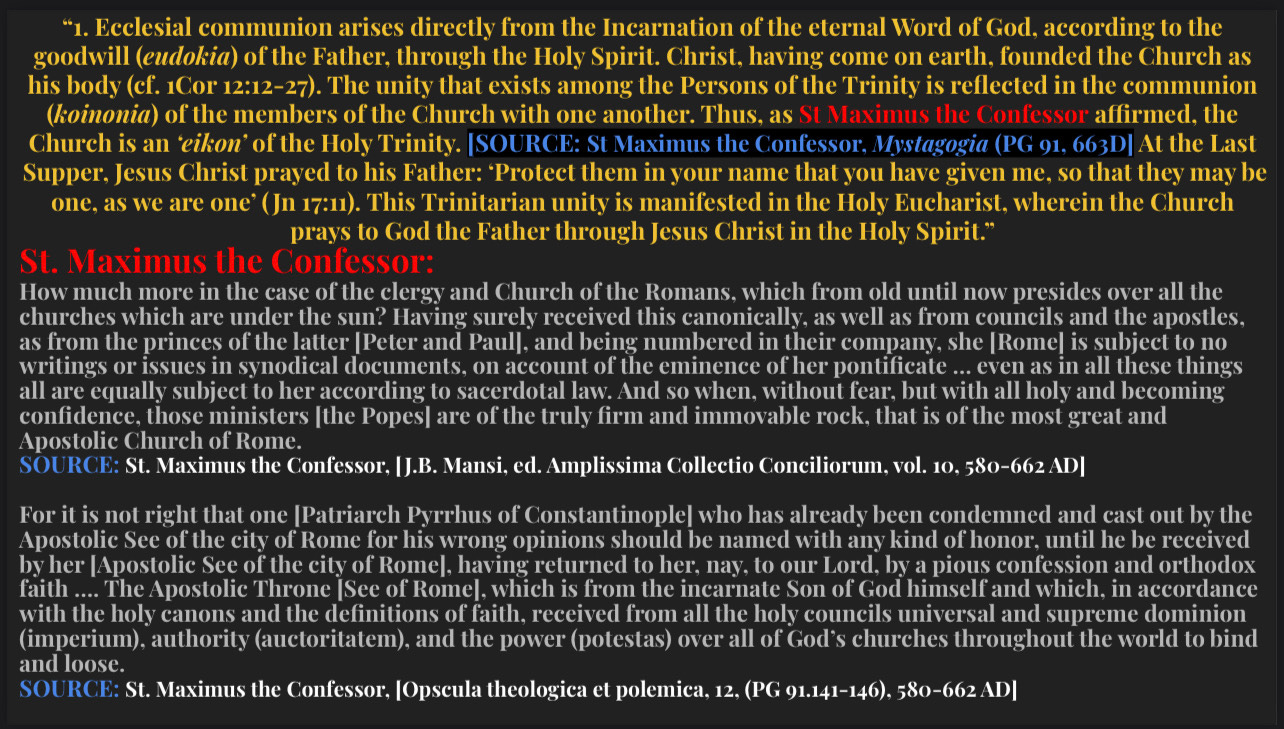
Point II:
From earliest times, the one Church existed as many local churches. The communion (koinonia) of the Holy Spirit (cf. 2Cor 13:13) was experienced both within each local church and in the relations between them as a unity in diversity. Under the guidance of the Spirit (cf. Jn 16:13), the Church developed patterns of order and various practices in accordance with its nature as a people brought into unity from the unity of the Father, the Son and the Holy Spirit. [SOURCE: St. Cyprian of Carthage, De Oral. Dom., 23 (PL 4. 536)]
Saint Cyprian of Carthage in the above point stresses the unified communion of the one church. However, in his Epistles, he points to the one body of Our Lord, as in “one Chair”, that is the Petrine See as pronounced by Jesus Christ unto His one altar; His one priesthood upon His Rock. St. Cyprian explained:
There is one God and one Christ, and one Church, and one Chair founded on the Rock[super petram, i.e. on Peter] by the voice of the Lord. It is not possible to set up another altar or another priesthood besides that one altar and that one priesthood. Whoever gathers elsewhere, scatters.(6)
He stresses the oneness of the priesthood, the altar upon the one Chair. Our Lord, endowed Saint Peter with the prime, supreme throne of unity; seemingly – St. Cyprian was in agreement.

POINT III:
Synodality is a fundamental quality of the Church as a whole. As St John Chrysostom said: “”Church” means both gathering (systema) and synod (synodos) [SOURCE: St. John Chrysostom, Explicatio in Ps 149 (PG 55. 493)] The term comes from the word ‘council’ (synodos in Greek, Concilium in Latin), which primarily denotes a gathering of bishops, under the guidance of the Holy Spirit, for common deliberation and action in caring for the Church. Broadly, it refers to the active participation of all the faithful in the life and mission of the Church.
The above point regards a “participation of all the faithful in the life and mission of the Church”, as “the guidance” of the bishoprics in their synodal gatherings is by The Holy Spirit. Therefore, just as the previous saints mentioned, St. John Chrysostom wrote pleasingly of St. John the Apostle displaying the apostle’s ecclesial provenance and authority:
[John] “is the pillar of the churches throughout the world, who hath the keys of the kingdom of heaven”(7)
Albeit, when he drafts his homilies for the gospel of Saint Matthew, he denotes The Son and The Father’s grace upon the Church. Likening St. Peter to the most efficient “fisherman” navigating through the onslaught of “waves” (enemies) against her, the Church. Further, he draws a likening between the prophet Jeremiah and St. Peter. Concerning Jeremiah, a pillar and wall; that is a nation whilst for St. Peter, a pillar and wall; “that is for all the world.”
“…that is on the faith of his confession. Thus he shows many will believe and raises his mind and makes him shepherd. Do you see how he himself leads Peter to high thoughts of him, and reveals himself and shows that he is the Son of God by these two promise? For those things which are peculiar to God alone, namely to forgive sins, and to make the Church immovable in such an onset of waves, and to declare a fisherman to be stronger than any rock while all the world wars against him, these things he himself promises to give; as the Father said, speaking to Jeremiah, that he would set him as a column of brass and as a wall — but him [Jeremiah] for one nation [Israel], this man [Peter] for all the world. I would ask those who wish to lessen the dignity of the Son, which gifts were greater, those which the Father gave to Peter, or those which the Son gave to him? The Father gave to Peter the revelation of the Son, but the Son gave to Peter to sow that of the Father and of himself throughout the world; and to a mortal man he entrusted such authority over all things in heaven, giving him the keys, who extended the Church throughout the world and declares it to be stronger than heaven”(8)
Perhaps what is more telling is the manner upon which St. John Chrysostom displays the supremacy of the Petrine See by highlighting the dignity of the Roman region or synod through the designation of Sts. Peter and Paul as “leader[s]”; he wrote:
“there shall we see Paul, with Peter, and as a chief and leader of the choir of the Saints, and shall enjoy his generous love[…] the city [of Rome] is more notable upon this ground, than upon all others together” […] Not so bright is the heaven, when the sun sends forth his rays, as is the city of Rome, sending out these two lights into all parts of the world.(9)
Saint Cyril of Jerusalem mirrored St. John Chrisostom concerning church leadership; Sts. Peter and Paul at Rome. He mentioned:
That goodly pair, Peter and Paul, the rulers of the Church, being present, set matters right again; […] for it was Peter, he who bears with him the keys of heaven […] for it was Paul, he who was caught up into the third Heaven, and into paradise, and who heard unspeakable words, which it is not lawful for a man to utter.(10)
Evidently, this leadership (or “rulers”) sentiment about the Church at Rome, according to a substantial margin of the patristic and apostolic era evidence, took common stance.

POINT IV:
4. The term primacy refers to being the first (primus. protos). In the Church, primacy belongs to her Head – Jesus Christ, who is the beginning. the firstborn from the dead: that in all things he might have the pre-eminence (protevon) (Col. 1:18). Christian Tradition makes it clear that, within the synodal life of the Church at various levels, a bishop has been acknowledged as the ‘first Jesus Christ associates this being ‘first’ with service (diakonia): ‘Whoever wants to be first must be last of all and servant of all’ (Mk 9:35).
The fourth point makes no reference to patristics or church history. However, Saint Augustine pairs the twentieth chapter of St. John’s gospel with “’Whoever wants to be first must be last of all and servant of all” from St. Mark’s gospel. Furthermore; he, to his exegesis, applies St. Matthew’s gospel (Ch. XVI v. xix). St. Augustine understood that the visible primacy, denoting leadership and unity, belonged to St. Peter but also notes that; the apostles had ecclesial authority. He held to the Catholic formula, therein acknowledging apostolic synodal authority while upholding, through primacy, St. Peter’s universal jurisdiction. The below image contains St. Augustine’s quote upon this matter.
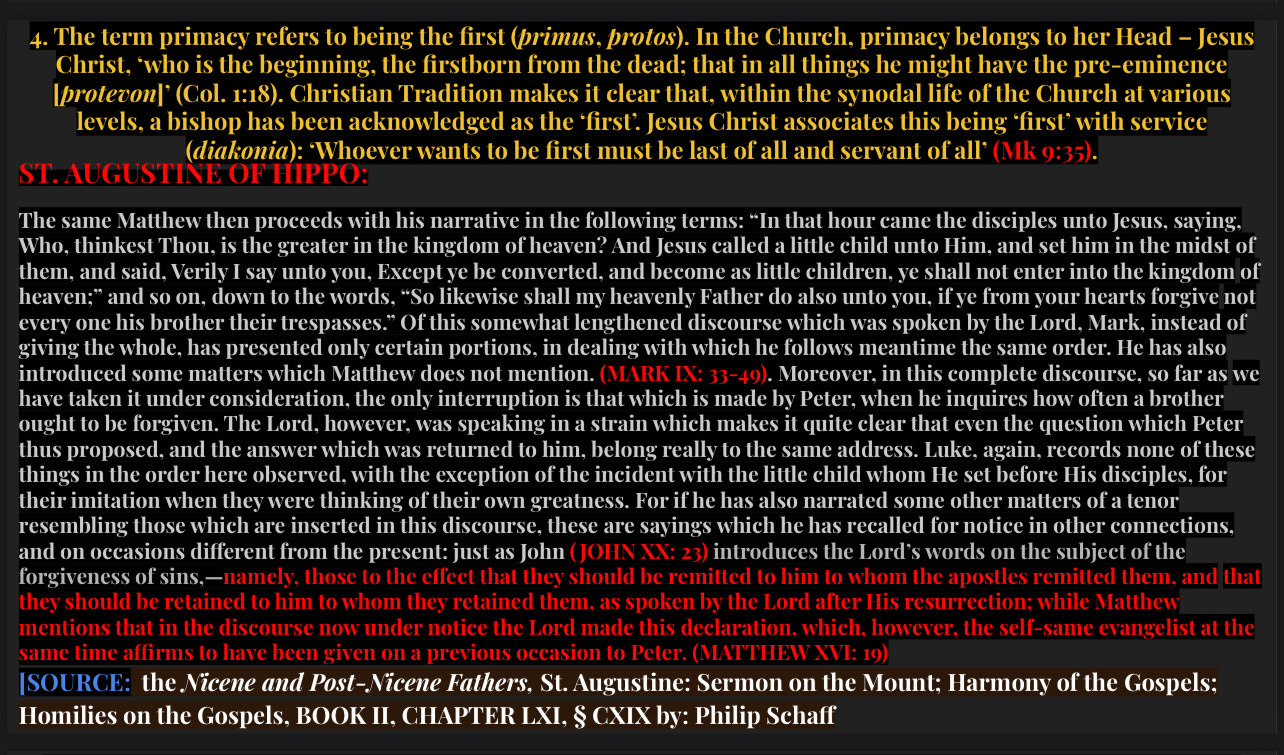
POINT V-VII:
5. In the second millennium, communion was broken between East and West. Many efforts have been made to restore communion between Catholics and Orthodox, but they have not succeeded. The Joint International Commission for Theological Dialogue between the Roman Catholic Church and the Orthodox Church, in its ongoing work to overcome theological divergences, has been considering the relationship between synodality and primacy in the life of the Church. Different understandings of these realities played a significant role in the division between Orthodox and Catholics. It is, therefore, essential to seek to establish a common understanding of these interrelated, complementary and inseparable realities.
6. In order to achieve this common understanding of primacy and synodality, it is necessary to reflect upon history. God reveals himself in history. It is particularly important to undertake together a theological reading of the history of the Church’s liturgy, spirituality, institutions and canons, which always have a theological dimension.
7. The history of the Church in the first millennium is decisive. Despite certain temporary ruptures, Christians from East and West lived in communion during that time, and, within that context, the essential structures of the Church were constituted. The relationship between synodality and primacy took various forms, which can give vital guidance to Orthodox and Catholics in their efforts to restore full communion today.
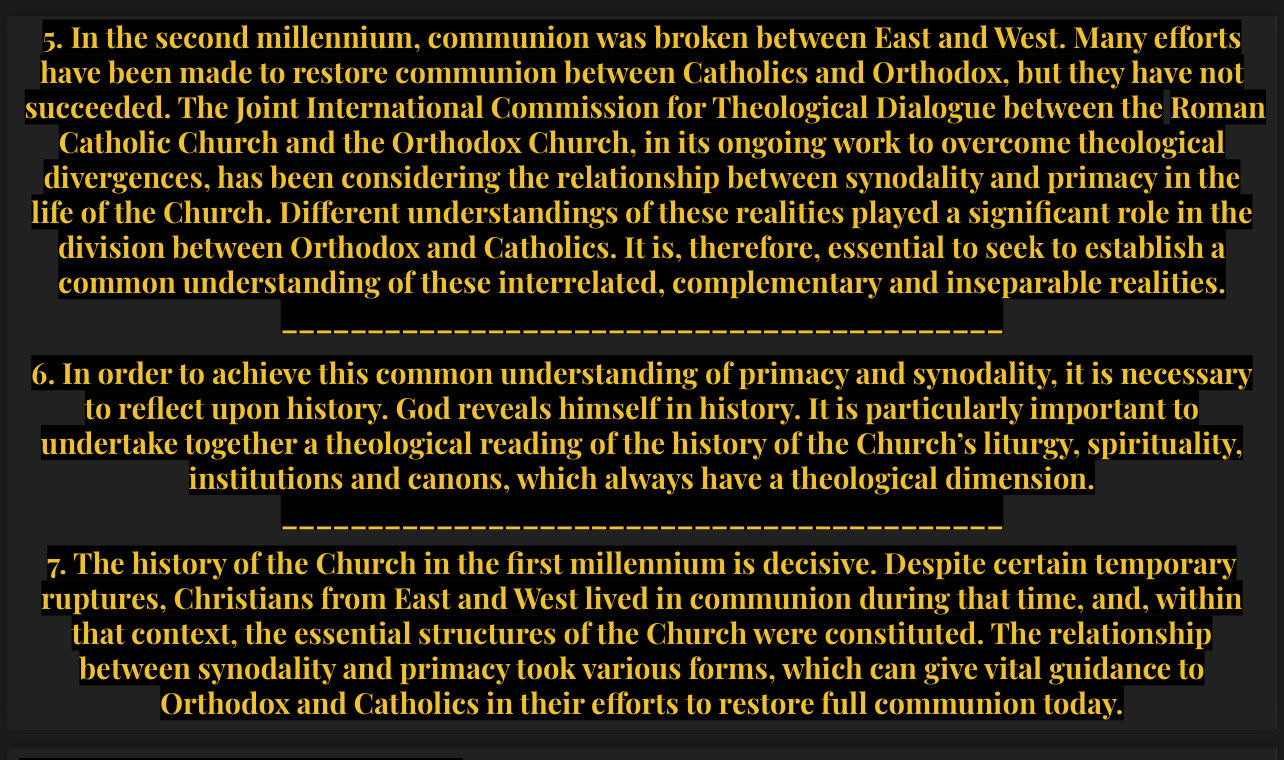
Great scholarship has attempted to explicate the notions within points five to seven. Dr. James Likoudis, a specialist in ecumenical relations between The Church East and West, provides valuable insight to the above three points. Catholic Answers (11) gives us a brief breakdown of his accolades and credentials;
“ […] is a former College Instructor in History and Government with over 20 years of teaching experience in public and private education. A nationally known writer and lecturer on Catechetics, Sex Education, and Liturgy, he is also the author of several books dealing with the ecclesiology of the Eastern Orthodox churches., including Ending the Byzantine Greek Schism, The Divine Primacy of the Bishop of Rome and Modern Eastern Orthodoxy: Letters to a Greek Orthodox on the Unity of the Church, and Eastern Orthodoxy And The See Of Peter: A Journey Toward Full Communion.” (12)
In his book The Divine Primacy of the Bishop of Rome and Modern Eastern Orthodoxy, Dr. James Likoudis illustrates the measures of “Unity, Sanctity, Catholicity, and Apostolicity” in relation to the schism between West and East; he wrote:
[…] maintain Catholic orthodoxy amidst the developments of heresy and schism. In the Catholic Church Unity has been brought about and preserved by the subordination of a multiplicity of bishops to their common visible head. The true Church’s indivisible Unity reveals its concrete reality only where the Roman Primacy of headship and supreme teaching authority in the Church is seen to be an essential feature of the Church’s visible organization and hierarchical constitution. The visible marks of Unity, Sanctity, Catholicity, and Apostolicity, therefore, cannot prescind from their linkage to the Roman Primacy as instituted by Christ. As T. Zapalena, S. observed in his “De Ecclesia Christi: Pars Apologetica” (Romae 1955): the “via notarum” “takes its nature and entire apologetical force from the promise, prediction and institution of Christ. But Christ instituted His Church upon Peter. Therefore, the primacy necessarily forms part of the Church’s true unity, catholicity, apostolicity, and indeed sanctity, at least the active, since the lawful administration of the means of salvation can only occur in dependence on Peter and his successor. (13)

Just as The Catholic claim, the Chieti document holds true to the ecclesial authority of apostolicity whilst holding true to the primacy of St. Peter as one that contains the charism of unity towards The Church universal. Not by happenstance but by critical assessment, Dr. James Likoudis agreed.
POINT VIII:
The one, holy, catholic and apostolic Church of which Christ is the head is present in the eucharistic synaxis of a local church under its bishop. He is the one who presides (the ‘proestos’). In the liturgical synaxis, the bishop makes visible the presence of Jesus Christ. In the local church (i.e. a diocese), the many faithful and clergy under the one bishop are united with one another in Christ, and are in communion with him in every aspect of the life of the Church, most especially in the celebration of the Eucharist. As St Ignatius of Antioch taught: ‘where the bishop is, there let all the people be, just as, where Jesus Christ is, we have the catholic church [katholike ekklesia – St Ignatius, Letter to the Smyrnaeans, 8]. Each local church celebrates in communion with all other local churches which confess the true faith and celebrate the same Eucharist. When a presbyter presides at the Eucharist, the local bishop is always commemorated as a sign of the unity of the local church. In the Eucharist, the proestos and the community are interdependent: the community cannot celebrate the Eucharist without a proestos, and the proestos, in turn, must celebrate with a community.
Saint Ignatius of Antioch, student of St. John the Apostle; as well understood the synodal authority of bishopric as the above point clarifies. However, he also understood the visible head of The Church to be at Rome. He was a forerunner to the previous saints mentioned, applying the same systematic ecclesiology. St. Ignatius of Antioch, in his address to the Roman church stated:
In the Greek, it states:
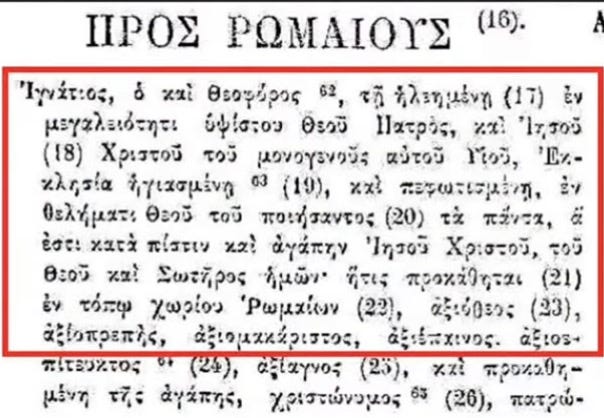
In the Latin, it states:
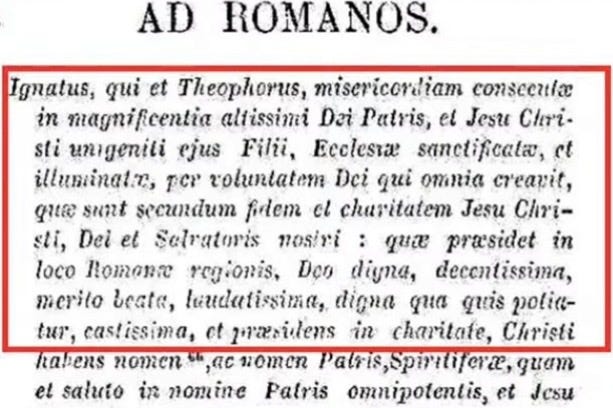
In English:
From Ignatius, whose other name is Theophorus,
To her who has found mercy in the greatness of the All-Highest Father, and Jesus Christ His only Son; to the church beloved and enlightened in her love to our God Jesus Christ by the will of Him who wills all things; to the church holding chief place in the territories of the district of Rome! – worthy of God, worthy of honour, blessing, praise, and success; worthy too in holiness, foremost in love, observing the law of Christ, and bearing the Father’s Name. (16)
He states; when addressing primacy, regarding the church at Rome, he stated; “church holding chief place in the territories of the district of Rome!”. It is without a doubt, he understood that regions have their respective bishops but all adhere to the universality of The Church at Rome. He went on to state; in the third chapter addressed to the Romans; as a confirmation displaying Rome’s jurisdiction; “You have never envied any one; you have taught others. Now I desire that those things may be confirmed (by your conduct), which in your instructions you enjoin (on others).” (17) Again, St. Ignatius expressed synodal authority of apostolicity while adhering to Roman primacy, the universal primacy endowed with the charism of unity (“you have taught others” and “instruction you enjoin”) and headship.

POINT IX-XI:
9. This interrelatedness between the proestos or bishop and the community is a constitutive element of the life of the local church. Together with the clergy, who are associated with his ministry, the local bishop acts in the midst of the faithful, who are Christ’s flock, as guarantor and servant of unity. As successor of the Apostles, he exercises his mission as one of service and love, shepherding his community, and leading it, as its head, to ever-deeper unity with Christ in the truth, maintaining the apostolic faith through the preaching of the Gospel and the celebration of the sacraments.
10. Since the bishop is the head of his local church, he represents his church to other local churches and in the communion of all the churches. Likewise, he makes that communion present to his own church. This is a fundamental principle of synodality.
The Regional Communion of Churches
11. There is abundant evidence that bishops in the early Church were conscious of having a shared responsibility for the Church as a whole. As St Cyprian said: ‘There is but one episcopate but it is spread amongst the harmonious host of all the numerous bishops’. [St. Cyprian, Ep.55, 24, 2; cf. also, ‘episcopatus unus est cuius a singulis in solidum pars tenetur (De unitate, 5).] This bond of unity was expressed in the requirement that at least three bishops should take part in the ordination (cheirotonia) of a new one; [First Ecumenical Council (Nicaca, 325), canon 4 & postolic Canon, 1: ‘A bishop must be ordained by two or three bishops’] it was also evident in the multiple gatherings of bishops in councils or synods to discuss in common issues of doctrine (dogma, didaskalia) and practice, and in their frequent exchanges of letters and mutual visits.

Points nine through eleven speak towards ecclesiology per regionem. In point eleven; it states that “bishops in the early Church were conscious of having a shared responsibility for the Church as a whole”. Of course, as consistently displayed in this examination; The Catholic Church acknowledges synodal and in this case; regional roles and authority. Interestingly, it goes on to make reference to Saint Cyprian of Carthage and Nicea I.
Firstly, if anyone intends a reading of these points to denote a relegation or contradiction to Roman primacy; they’d unfortunately be either mislead or they’re misunderstanding St. Cyprian’s ecclesial views and ignorant to the whole of his corpus of works. St. Cyprian was also very clear in his writings when he tied the whole of The Church [St. Matthew’s gospel (ch. XVI)] to St. Peter. He also then states that no other church (“altar” or “priesthood”) can be formed. He wrote:
“[Jeremiah 23:16-17] They are now offering peace who have not peace themselves. They are promising to bring back and recall the lapsed into the Church, who themselves have departed from the Church. There is one God and one Christ, and one Church, and one Chair founded on the Rock [Peter] by the voice of the Lord. It is not possible to set up another altar or another priesthood besides that one altar and that one priesthood. Whoever gathers elsewhere, scatters.” (18)
Interestingly, this quote by St. Cyprian, in this regional application; expressed the very same sentiment as St. John Chrysostom when comparing St. Peter to Jeremiah the prophet [please consult reference number 8]. They both draw the same conclusion and in the Chieti document, these holy saints are cited through frames of universal, regional and local ecclesial jurisdiction.
Secondly, in view of The First Ecumenical Council; Nicea I. Well known for the intuition of the dogma fortifying the deity of Our Lord contra-Arius and his abomination monikered The Arian Heresy. St. Athanasius of Alexandria, bishop and doctor of The Church, the very champion of orthodoxy (of the epoch) within Nicene theology, who was not only in attendance for Nicea I, but he also; in his De Sententia Dionysii wrote:
The following is the occasion of his writing the other letters. The Bishop Dionysius having heard of the affairs in Pentapolis and having written, in zeal for religion, as I said above, his letter to Euphranor and Ammonius against the heresy of Sabellius, some of the brethren belonging to the Church, of right opinions, but without asking him, so as to learn from himself how he had written, went up to Rome; and they spoke against him in the presence of his namesake Dionysius the Bishop of Rome. And he, upon hearing it, wrote simultaneously against the partisans of Sabellius and against those who held the very opinions for uttering which Arius was cast out of the Church; calling it an equal and opposite impicty to hold with Sabellius, or with those who say that the Word of God is a thing made and formed and originated. And he wrote also to Dionysius to inform him of what they had said about him. And the latter straightway wrote back, and inscribed his books ‘a Refutation and a Defence. Here mark the detestable gang of the adversaries of Christ, and how they themselves have stirred up their disgrace against themselves. For Dionysius, Bishop of Rome, having written also against those who said that the Son of God was a creature and a created thing, it is manifest that not now for the first time but from of old the heresy of the Arian adversaries of Christ has been anathematised by all. And Dionysius, Bishop of Alexandria, making his defense concerning the letter he had written, appears in his turn as neither thinking as they allege, nor having held the Arian error at all. (19)
St. Athanasius demonstrates a few crucial notions in this letter. By virtue of the primacy, they “spoke against him in the presence of his namesake Dionysius the Bishop of Rome.” Let’s enumerate what is meant by St. Athanasius in the quote above:
- The declaration of heresy (by the bishop of Rome) equal to that of Sabellius.
- The travel to Rome (of Dionysius of Alexandria) for the pronouncement of heresy by bishop Dionysius of Rome vis-à-vis Arius and Arianism.
- Bishop Dionysius of Rome is he who “cast[s] out of The Church” the heretics.
- How the casting out of heretics done by Dionysius of Rome meant they were “anathematised by all”.
- Dionysius, the Bishop of Alexandria, having to “[write] (wrote) back” to Dionysius (bishop of Rome) producing a defence and clarifying his sound doctrine inline with that of Rome’s priesthood.
Episcopal authority is upheld in St. Athanasius’ view, though the universality of The Church is upheld by the Roman bishop. Of course, like the previous saints; this is not coincidental.

POINT XII-XIII:
12. Already during the first four centuries, various groupings of dioceses within particular regions emerged. The protos, the first among the bishops of the region, was the bishop of the first see, the metropolis, and his office as metropolitan was always attached to his see. The ecumenical councils attributed certain prerogatives (presbeia, pronomia, dikaia) to the metropolitan, always within the framework of synodality. Thus, the First Ecumenical Council (Nicaea, 325), while requiring of all the bishops of a province their personal participation in or written agreement to an episcopal election and consecration – a synodical act par excellence – attributed to the metropolitan the validation (kyros) of the election of a new bishop. (SOURCE: First Ecumenical Council (Nicaca, 325), canon 4; also canon 6)The Fourth Ecumenical Council (Chalcedon, 451) again evoked the rights (dikaia) of the metropolitan – insisting that this office is ecclesial, not political (SOURCE: Fourth Ecumenical Council (Chalcedon, 451), canon 12) – as did the Seventh Ecumenical Council (Nicaea II, 787), also.(SOURCE: Seventh Ecumenical Council (Nicaca II, 787), canon 11)
13. Apostolic Canon 34 offers a canonical description of the correlation between the protos and the other bishops of each region: ‘The bishops of the people of a province or region [ethnos] must recognize the one who is first [protos] amongst them, and consider him to be their head [kephale], and not do anything important without his consent [gnome]; each bishop may only do what concerns his own diocese [paroikia] and its dependent territories. But the first [protos] cannot do anything without the consent of all. For in this way concord [homonoia] will prevail, and God will be praised through the Lord in the Holy Spirit’. (SOURCE: Council of Antioch (327), canon 9)

In points 12 and 13, various councils are cited, they are; Nicea I, Chalcedon and Nicea II. Canons from these councils are used though, when viewing the councils as a whole; the fullness of the truth appears. Firstly, with Nicea I, the historian Luke Rivington (M.A), in his The Primitive Church and the See of Peter wrote:
“The two priests signed next, and then Alexandria, Antioch, and Jerusalem. Some writers have en-devoured to evade the force of this fact, by suggesting that Hosius was made president, as the emperor’s favourite, and from general respect for his character. One can hardly suppose that the suggestion could be due to anything but the exigencies of a theory which is opposed to the idea that Rome presided.[…] It is admitted on all hands, that long before the Council of Nicea the See of Rome was considered to be the See of Peter, and we have already seen that there is irrefragable proof that Alexandria acted as at least in some sense subordinate to Rome. It is freely admitted on all sides that Rome had a primacy of honour by those who deny her primacy of jurisdiction. Yet, according to this strange theory, her primacy of honour did not involve even the presidency at the first Ecumenical Council. What did that primacy of honour involve? Further, the sees are, even on this theory, placed in their usual order after the president’s signature, viz. first the papal legates, then Alexandria, and then Antioch.” (20)
The historian Dr. Luke Rivington, a convert from anglicanism to catholicism properly points out that; the See of Rome; through St. Peter and onto pope St. Sylvester I (his successor) sends legates and yet: they still have authority of “Primacy” over the council as they are to sign onto the council before all other synods. Rivington, when referring to Alexandria says: They are “subordinate to Rome”. Furthermore, he goes onto enumerate the synods in a hierarchical manner placing “The Papal Legates [as primacy] then Alexandria and then Antioch”. Consult images below Dr. Rivington’s statement…


Secondly; regarding Chalcedon, it is difficult to be of witness to anything apart from Roman supremacy. In Session I of Chalcedon, it states:
Paschasinus, the most reverend bishop and legate of the Apostolic See, stood up in the midst with his most reverend colleagues and said: We received directions at the hands of the most blessed and apostolic bishop of the Roman city, which is the head of all the churches, which directions say that Dioscorus is not to be allowed a seat in this assembly, but that if he should attempt to take his seat he is to be cast out. This instruction we must carry out; if now your holiness so commands let him be expelled or else we leave.
The most glorious judges and the full senate said: What special charge do you prefer against the most reverend bishop Dioscorus?
Paschasinus, the most reverend bishop and legate of the Apostolic See, said: Since he has come, it is necessary that objection be made to him.
The most glorious judges and the whole senate said: In accordance with what has been said, let the charge under which he lies, be specifically made.
Lucentius, the most reverend bishop having the place of the Apostolic See, said: Let him give a reason for his judgment. For he undertook to give sentence against one over whom he had no jurisdiction. And he dared to hold a synod without the authority of the Apostolic See [of Rome], a thing which had never taken place nor can take place. (21)
The very emperor who convened the Council of Chalcedon in AD 451, Emperor Marcian, who is a saint exclusively in Eastern Orthodoxy, wrote to Pope St. Leo I the Great:
In all that concerns the Catholic religion and the faith of Christians, we have thought it right to approach in the first place Your Holiness who is overseer and guardian of the divine faith. (22)
Or perhaps in the case of Empress Pulcheria, also exclusively a saint in Eastern Orthodoxy, when she as well wrote to Pope St. Leo I the Great:
[I am sure that the council] will define the Catholic belief by your authority [sou auqentounto] as Christian faith and piety require. (23)
Indeed the Council of Chalcedon does not undermine apostolicity, however neither does it undermines Roman primacy (both honorific and of unifying ecclesial, Catholic authority).
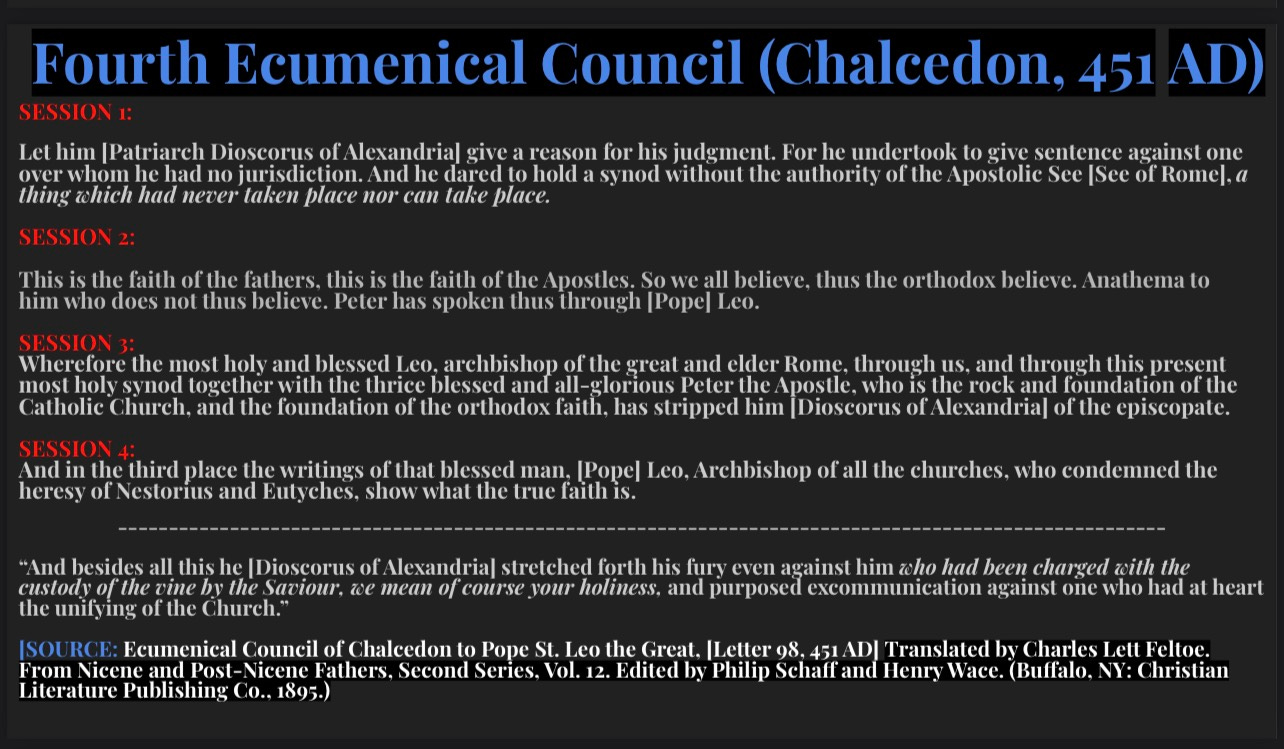
Lastly, the reference to Nicea II is a curious one as it famously, like the previous ecumenical councils, evidently displays the primacy of The Petrine See which Pope Hadrian beheld. For instance, Emperor Constantine VI and Empress Irene of Athens wrote to pope Hadrian:
They (the See of Rome) who receive the dignity of the empire, or the honour of the principal priesthood from our Lord Jesus Christ, ought to provide and to care for those things which please him, and rule and govern the people committed to their care according to his will and good pleasure. Therefore, O Most Holy Head [Caput], it is incumbent upon us and you, that irreprehensibly we know the things which be his, and that in these we exercise ourselves, since from him (Christ) we have received the imperial dignity, and you the dignity of the chief priesthood … As then you are the veritable chief priest (primus sacerdos) who presides in the place and in the see of the holy and superlaudable Apostle Peter, let your paternal blessedness come to us. (24)
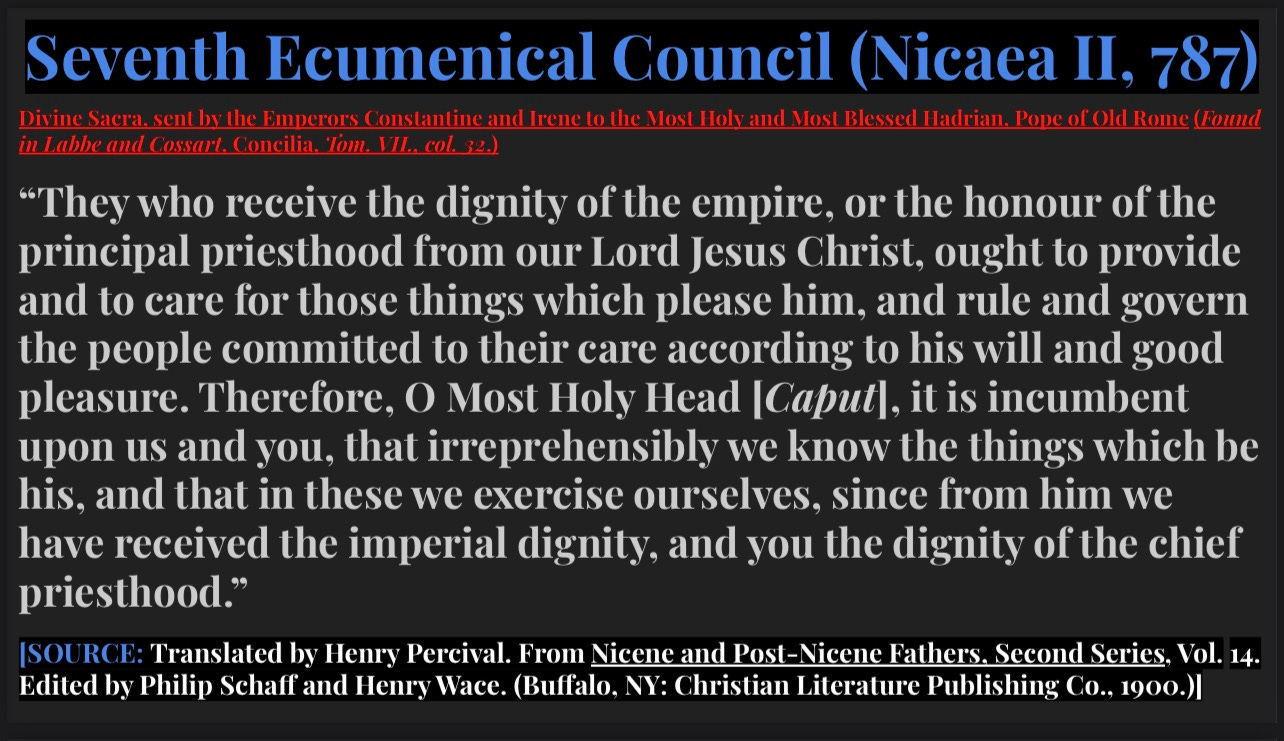
This letter indicates the upholding of apostolic jurisdiction and therein, ecclesial authority. Constantine VI and his mother Irene of Athens wrote of the “incumben[cy] upon us [The eastern emperor and empress or “imperial dignity”] and you [Pope Hadrian]” highlighting their apostolic legitimacy just as the previous the saints, as early as Ignatius of Antioch (for instance) and councils affirmed. However, true to historical paradigm and pattern, they also uphold the “primus” of “the see of the holy and superlaudable Apostle Peter”. It is far greater witnessed when assessing the Moechian Controversy (25) which arose as Emperor Constantine VI, in AD 780: a mere 7 years before Nicea II, entered into an adulterous marriage with his mother’s servant, Theodote. Such would not have been problematic except, the Emperor; to facilitate this marriage, forced his wife into a cenobium. In AD 795, after 15 years of sacramental abuses in Constantinople, St. Theodore the Studite of Constantinople wrote and appealed to Pope St. Leo III:
Since Christ our God has granted to the great Peter, in addition to the keys to the kingdom of heaven, the dignity of being the first [Primate] among pastors, it is necessary to report to Peter or his successor [Pope] everything new that has been introduced in the catholic Church by those deviating from the truth. Thus, having learned to do this from our ancient holy fathers, we too, the most humble and lowly of all, in view of the innovation introduced to our Church, consider it our duty… to report this to the Angel of your supreme beatitude in our humble letter.(26)
Though it was officiated by the Abbot Joseph [see reference 25], the union was never blessed by Patriarch Tarasius (of Constantinople), however he evidently turned a blind-eye, thus allowing for the Emperor to besmirch the sacrament of matrimony. The blasphemous union lasted until AD 797, that is when the Emperor died. Only then, after his death, did Patriarch Tarasius reprimand the Abbot Joseph. Just as the first ecumenical council; Nicea I proclaims the authoritative and honorific charism of ecclesial unity via the primacy of the Petrine throne; as does Nicea II and does not, in any way; erode papal claims. View the image below for more, relevant sources…
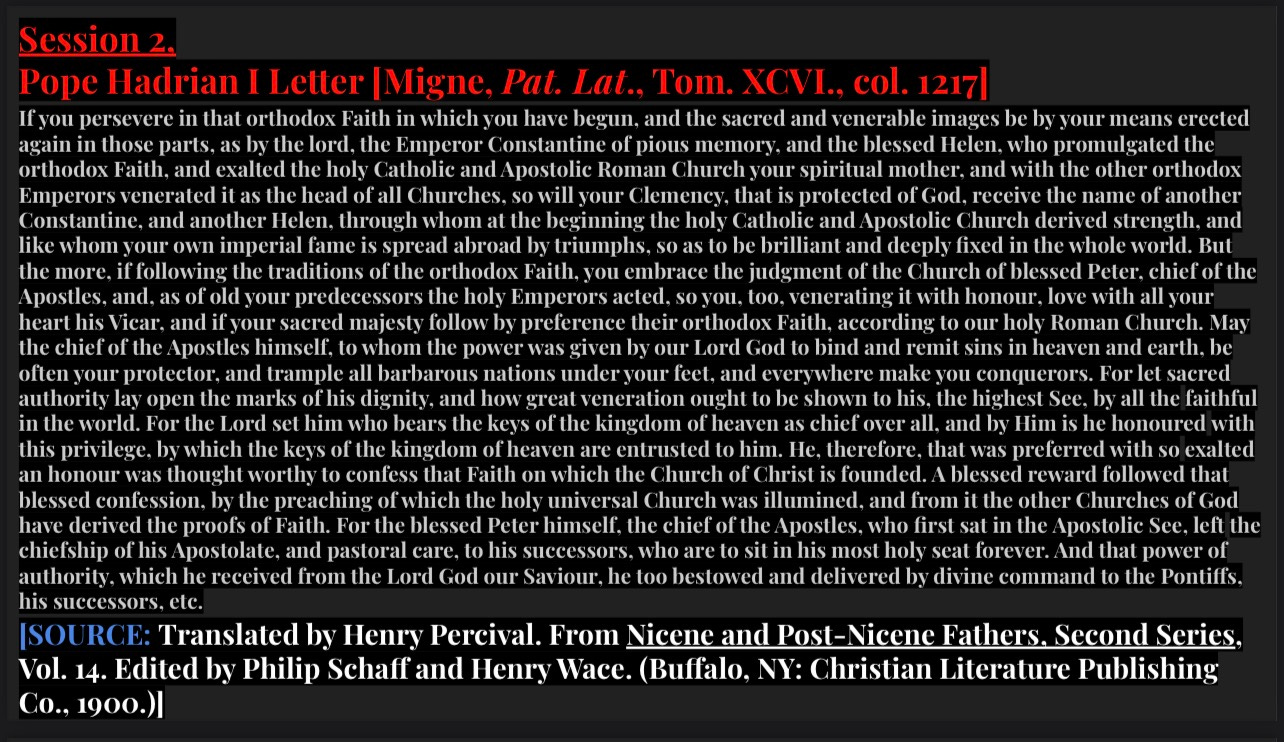
POINT XIV-XVI
14. The institution of the metropolitanate is one form of regional communion between local churches. Subsequently other forms developed, namely the patriarchates comprising several metropolitanates. Both a metropolitan and a patriarch were diocesan bishops with full episcopal power within their own dioceses. In matters related to their respective metropolitanates or patriarchates, however, they had to act in accord with their fellow bishops. This way of acting is at the root of synodical institutions in the strict sense of the term, such as a regional synod of bishops. These synods were convened and presided over by the metropolitan or the patriarch. He and all the bishops acted in mutual complementarity and were accountable to the synod.
The Church at the Universal Level
15. Between the fourth and the seventh centuries, the order (taxis) of the five patriarchal sees came to be recognised, based on and sanctioned by the ecumenical councils, with the see of Rome occupying the first place, exercising a primacy of honour (presbeia tes times), followed by the sees of Constantinople, Alexandria, Antioch and Jerusalem, in that specific order, according to the canonical tradition.
16. In the West, the primacy of the see of Rome was understood, particularly from the fourth century onwards, with reference to Peter’s role among the Apostles. The primacy of the bishop of Rome among the bishops was gradually interpreted as a prerogative that was his because he was successor of Peter, the first of the apostles. This understanding was not adopted in the East, which had a different interpretation of the Scriptures and the Fathers on this point. Our dialogue may return to this matter in the future.
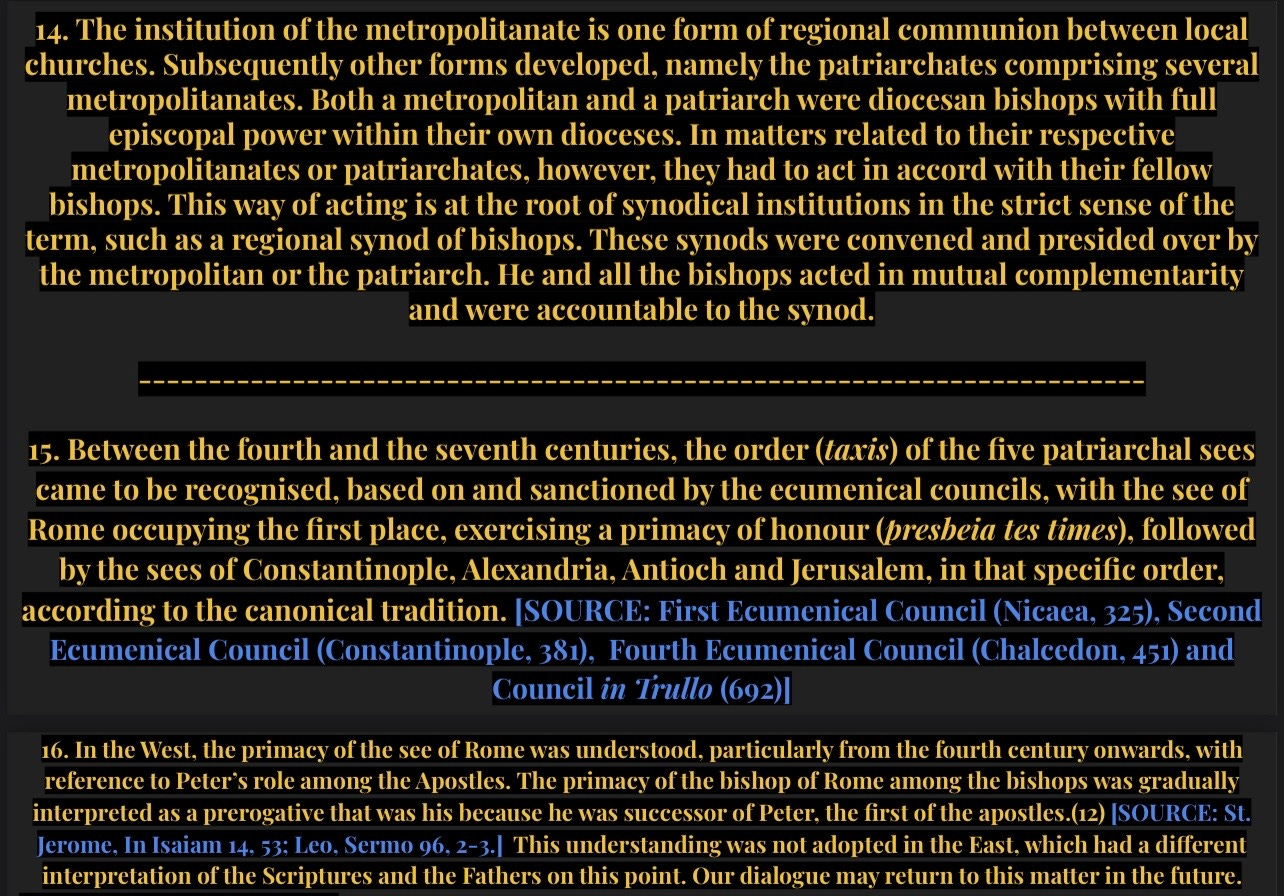
The document makes reference to Saint Jerome, it is a wonder as to how anyone who is not Catholic can utilize a document citing his work. His rhetoric was identical to the very many previously cited in this article, St. Jerome however minced not his words when he wrote to Jovinianus, a person with a great many errors that were condemned at the synods Rome and Milan (27). He wrote:
“But you say that the Church is founded upon Peter although the same thing is done in another place upon all the apostles, and all receive the kingdom of heaven, and the solidity of the Church is established equally upon all, nevertheless among the twelve one is therefore chosen that by the appointment of a head an occasion of dissension may be taken away”(28)
Though apostolicity grants for synodal “equal[ity] upon all”, the “one that is therefore chosen” is therein endowed with charisms befitting ecclesial, universal unity. Moreover, in his other works; he highlights papal indefectibility, infallibility and supremacy. View the below image.
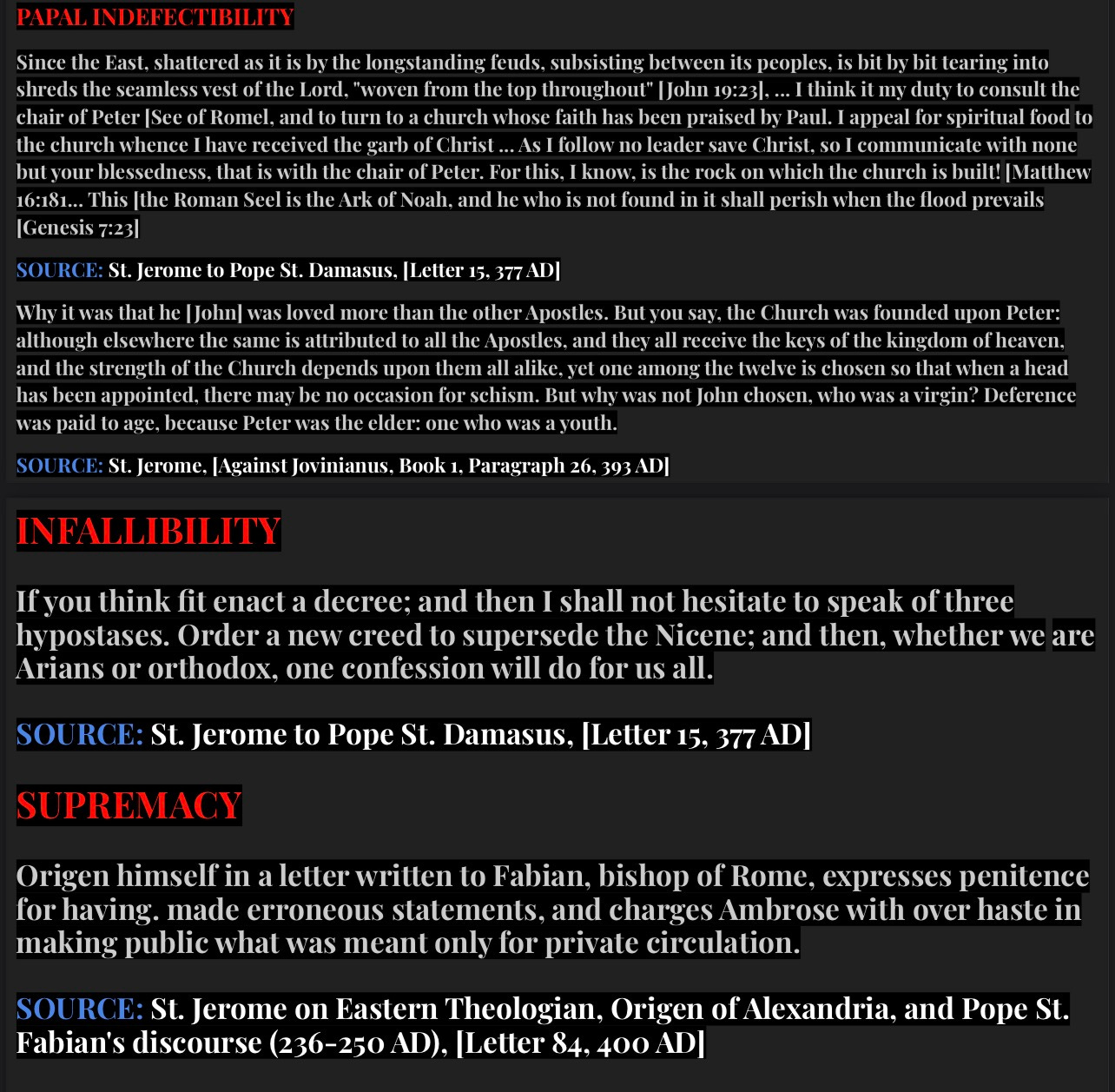
There are countless patristic, papal attestations that from St. Jerome’s timeframe. For instance, whilst Jerome not only explicated upon papal charisms and dogma but he also remained obedient to Pope Saint Damasus I; who is succeeded by Pope Saint Siricius who wrote to Bishop Himerius of Tarragona (Spain) highlighting similar notions:
“For in view of our office there is no freedom for us, on whom a zeal for the Christian religion is incumbent greater than on all others, to dissimulate or to be silent. We [Rome] bear the burdens of all who are oppressed, or rather the blessed apostle Peter, who in all things protects and preserves us, the heirs, as we trust, of his administration, bears them in us […] Enough error on this matter! All priests who do not wish to be torn from the solidity of the apostolic rock, upon which Christ built the universal Church [the Roman Church] should now hold the aforementioned rule […] let them know that they have been expelled by the authority of the apostolic see [See of Rome] from every ecclesiastical office, which they used unworthily nor can they ever touch the mysteries which ought to be venerated, of which they deprived themselves when they were obsessed with obscene desires.” (29)
The understanding of equal ecclesial authority across respective bishoprics is very much part of Catholic ecclesiology. However, as Pope St. Siricius wrote; primacy entails that; “[Rome] bear[s] the burdens of all who are oppressed, or rather the blessed apostle Peter, who in all things protects and preserves us, the heirs, as we trust, of his administration, bears them in us”. Thus Petrine universality (effective and affective upon “every ecclesiastical office”) can pronounce anathema and all must abide. For supplementary sources, consult the following graphics:
POINT XVII-XIX
17. When a new patriarch was elected to one of the five sees in the taxis, the normal practice was that he would send a letter to all the other patriarchs, announcing his election and including a profession of faith. Such ‘letters of communion’ profoundly expressed the canonical bond of communion among the patriarchs. By including the new patriarch’s name, in the proper order, in the diptychs of their churches, read in the Liturgy, the other patriarchs acknowledged his election. The taxis of the patriarchal sees had its highest expression in the celebration of the holy Eucharist. Whenever two or more patriarchs gathered to celebrate the Eucharist, they would stand according to the taxis. This practice manifested the eucharistic character of their communion.
18. From the First Ecumenical Council (Nicaea, 325) onwards, major questions regarding faith and canonical order in the Church were discussed and resolved by the ecumenical councils. Though the bishop of Rome was not personally present at any of those councils, in each case either he was represented by his legates or he agreed with the council’s conclusions post factum. The Church’s understanding of the criteria for the reception of a council as ecumenical developed over the course of the first millennium. For example, prompted by historical circumstances, the Seventh Ecumenical Council (Nicaea II, 787) gave a detailed description of the criteria as then understood: the agreement (symphonia) of the heads of the churches, the cooperation (synergeia) of the bishop of Rome, and the agreement of the other patriarchs (symphronountes). An ecumenical council must have its own proper number in the sequence of ecumenical councils, and its teaching must accord with that of previous councils. Reception by the Church as a whole has always been the ultimate criterion for the ecumenicity of a council.
19. Over the centuries, a number of appeals were made to the bishop of Rome, also from the East, in disciplinary matters, such as the deposition of a bishop. An attempt was made at the Synod of Sardica to establish rules for such a procedure. Sardica was received at the Council in Trullo (692). The canons of Sardica determined that a bishop who had been condemned could appeal to the bishop of Rome, and that the latter, if he deemed it appropriate, might order a retrial, to be conducted by the bishops in the province neighbouring the bishop’s own. Appeals regarding disciplinary matters were also made to the see of Constantinople,(16) and to other sees. Such appeals to major sees were always treated in a synodical way. Appeals to the bishop of Rome from the East expressed the communion of the Church, but the bishop of Rome did not exercise canonical authority over the churches of the East.

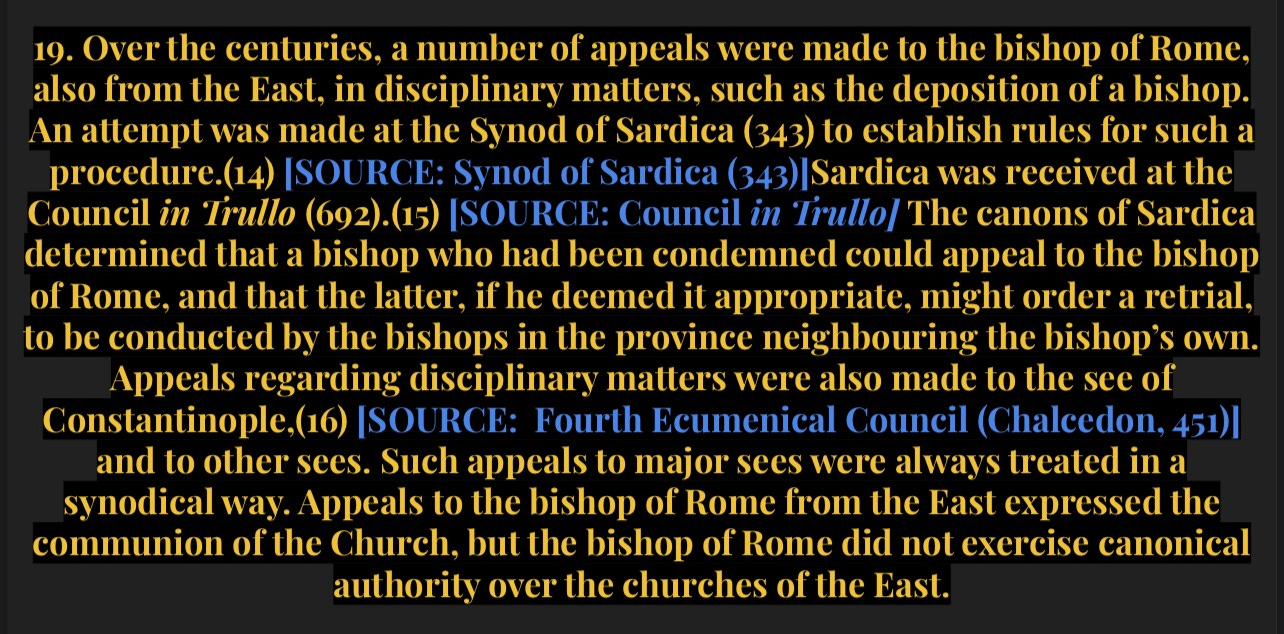
Points XVII to XIX address universal authority. Curiously, the document makes reference to:
- Ecu. Nicea II (AD 787)
- Synod of Sardica/Serdica (AD 343)
- Council of Trullo or Quinisext (AD 691)
- Ecu. Chalcedon (AD 451)
In every one of these conventions, the Petrine See is seen with universality; not simply honorific (as the naysayers would express) but one of authority in the charism of ecumenical unity and ratification of pronouncements of dogma. Firstly, the seventh Ecumenical Council of Nicea II. It is relevant to the understanding of this council that one underpins Emperor Leo III and his son/successor, Emperor Constantine V’s heretical propagation of Iconoclasm. The anti-icon sentiment they espoused, historically; began in AD 717 but Constantine V ratifies the sentiment into empirical policy (or law) in AD 754.(30) St. Theodore the Studite of Constantinople remarked in his letter to Pope Paschal I, about the iconoclasts he wrote:
“[…] separated themselves from the body of Christ, and from the chief throne in which Christ placed the keys of faith: against which the gates of hell, namely the mouths of heretics, have not prevailed up to now, nor shall they ever prevail, according to the promise of him who does not lie. Therefore let the most blessed and apostolic Paschal, who is worthy of his name, rejoice, for he has fulfilled the work of Peter.”(31)
Famously, this council is championed by the likes (or their works) of Popes Sts. Gregory II and Gregory III; furthermore St. John of Damascus. The iconoclasm was defeated in AD 787 but re-emerged in the early AD 810s and done away with (again) by the end of the AD 810s. To address our separated, schismatic Eastern Orthodox peers, we view what St. John of Damascus wrote:
“Today the supreme head of the New Covenant – the one who proclaimed Christ as Son of God [Peter] most clearly when he said. ‘You are the Christ, the Son of the living God’ – sees the leader of the Old Covenant [Moses] standing next to the lawgiver of both.” (32)
The Doctor of the Church, the Damascene continues;
But why did He [Jesus] take along Peter and James and John? Peter, because he wanted to show him that the witness, which [Peter] had truly borne, was now confirmed by the witness of The Father, and to make credible His [i.e. Jesus’] own statement that the heavenly Father had revealed this to him [i. e. Peter]; and because as president he was also receiving the oars of the entire Church.” (33)
If the likes of St. John Damascene and St. Theodore the Studite sufficed not (vis-à-vis iconoclasm); there’s the case of Pope Hadrian and his letters to Nicea II. The naysayers attempt to draw a sort of confusion by mentioning the stylistic, linguistic differences between the Latin and the Greek transcripts (in a future article, I’ll address this laughable claim). However, what is not confused, from the earlier referenced address from Emperor Constantine VI and his mother Empress Irene of Athens to Pope Hadrian [see reference 24], is the correspondence, where “holy images” (icons) are mentioned, between Pope Hadrian and the King (of the Franks and later Emperor of Rome) Charlemagne. (34) Pope Hadrian wrote:
“We have made as yet no reply to the Emperors, fearing they may return to their error. We exhorted them long ago about the images and the dioceses of the archbishops which… we sought to restore to the Holy Catholic and Apostolic Roman Church, which they sequestered together with our patrimonies at the time they overthrew the holy images. To those exhortations, they never replied. They have returned in one point from their errors, but in the other two they remain where they were [dioceses of Southern Italy]… If your God-protected Royal Excellency agrees we repeat our exhortation [to Constantinople, expressing gratitude that the holy images are in their former state. But as to the dioceses of our holy Roman churches… and the patrimonies we warn the Emperor solemnly that if he does not restore them to our Holy Roman Church, we shall decree him a heretic for persistence in this error.” (35)
If Nicea II is of any indication, it’s of Papal supremacy. Attestations of the Emperor, Eastern and Western saints and the Petrine Throne confirm. For the Epistolam Nicea II by Pope Hadrian, consult the following image:

Secondly, the Synod of Sardica. Though it was monikered and held, by the West; as Sardica. It was adjacently held by the East as the Synod of Philippopolis. Hence, we will look at the Greek and the Latin manuscripts. Here are certain, interesting canons of these conventions. For instance; Canon 4 in the Greek:
Γαυδέντιος ἐπίσκος εἷπεν• Εἰ δοκεῖ, ἀναγκαῖον προστεθῆναι ταύτῃ τῇ ἀποφάσει, ἥντιμα ἁγάπης εἰλικρινοῦς πλήρη ἐξενήνοχας, ὥστε ἐαν τις ἐπίσκοπος καθαιρεθῇ τῇ κρίσει τούτων τῶν ἐπισκόπων τῶν ἐν γειτνίᾳ τυγχανόντων, καὶ φάσκῃ πάλιν ἑαυτῷ ἀπολογίας πρᾶγμα ἐπιβάλλειν, μὴ πρότερον εἰς τὴν καθέδραν αὐτοῦ ἕτερον ὑποκαταστῆναι ἐὰν μὴ ὁ τῆς Ῥωμαίων ἐπίσκοπος ἐπιγνοὺς περὶ τούτου ὅρον ἐξενέγκῃ. (36)
As it is translated in English:
The presbyterial bishop said, “If it is necessary to add to this decision, the dignity of sincere love, complete exclusivity, so that if the bishop deposes them in the judgment of these bishops in the neighborhood, and again imposes an apology on himself, no more.” to be substituted in his chair unless the bishop of the Romans excommunicates him about this.
The same Canon 4, but in Latin:
Gaudentius episcopus dixit: Addendum si placet huic septentiæ, quam plenam sanctitate protulisti, ut cum aliquis episcopus depositus fuerit eorum episcoporum judicio, qui in vicinis locis commorantur, et proclamaverit agendum sibi negotium in urbe Roma; alter episcopus in ejus cathedra post appellationem ejus, qui videtur esse depositus, omnino non ordinetur, nisi causa fuerit in judicio episcopi Romani determinata. (37)
As it is translated in English:
Gaudentius, the bishop, said: We must add, if it pleases you, to this seventy, which you brought forth with full sanctity, as when a certain bishop has been deposed by the judgment of those bishops who reside in neighboring places, and has proclaimed that business should be done for him in the city of Rome; another bishop in his chair after his appeal, who seems to have been deposed, will not be ordained at all, unless the cause has been determined in the judgment of the bishop of Rome.
Additionally, we can view (in the Greek) Canon 9:
Ὅσιος ἐπίσκοπος εἶπε• Καὶ τοῦτο ἀκόλουθον νομίζω εἶναι, ἵνα ἐὰν ἐν οἱᾳδηποτοῦτν ἐπαρχίᾳ ἀπίσκοποι πρὸς ἀδελφόν καὶ συνεπίσκοπον ἑαυτῶν ἀποστέλλοιεν δεήσεις, ὁ ἐν τῇ μείζονι τυγχάνων πόλει, τοῦτιʼ ἔστι τῇ μητροπόλει, αὐτὸς καὶ τόν διάκονον αὐτοῦ κιὰ τὰς δεήσεις ἀποστέλλοι, παρέχων αὐτῷ καὶ συστατικὰχ ἐπιστολὰς, γράφων δηλονότι κατὰ ἀκολουθίαν καὶ πρὸς τοὺς ἀδελφοὺς κιὰ συνεπισκόπους ἡμῶν, εἴ τινες ἐν ἐκείνῳ τῷ καιρῷ ἐν τοῖς τόποις ἢ ἐν ταῖς πόλεσι διάγοιεν, ἐν αἶς ὁ εὐσβέστατος βασιλεὺς τὰ δημόσια πράγματα διακυβερνᾷ.
Εἰ δὲ ἔχοι τις τῶν ἐπισκόπων φίλους ἐν τῇ αὐλῇ τοῦ παλατίου καὶ βούλοιτο περί τινος ὅπερ πρεπωδέστερον εἴη ἀξιῶσαι, μὴ κωλύοιτο διὰ τοῦ ἑαυτοῦ διακόνου καὶ ἀξiῶσαι καὶ ἐντείλασθαι τούτοις, ὥστε τὴν αὐτῶν ἀγαθὴν βοήθειαν ἀξιοῦντι αὐτῷ παρέχειν.
Οἱ δὲ εἰς Ῥώμην παραγινόμενοι, καθὼς προείρηκα, τῷ ἀγαπητῷ ἀδελφῷ ἡμῶν καὶ συνεπισκόπῳ Ἰουλίῳ τὰς δεήσεις, ἃς ἔχοιεν διδόναι, ὀφείλουσι παρέχειν, ἵνα πρότερος αὐτὸς δοκιμάζῃ• εἰ μή τινες ἐξ αὐτῶν ἀναισχυντοῖεν, καὶ οὕτω τὴν ἑαυτοῦ προστασίαν καὶ φροντίδα παρέχων εἰς τὸ στρατόπεδον αὐτοὺς ἀποστέλλοι ἅπαντες οἱ ἐπίσκοποι ἀπεκρίναντο, ἀρέσκειν αὐτοῖς, καὶ περπωδεστάτην εἶναι τὴν συμβουλὴν ταύτην. (38)
As it is translated in English:
And the bishop said, I think that it is well, that when the bishops of the province shall be gone to the brethren, and their bishops shall send their greetings, he and his deacon, and his bishops shall send them to the cities of the provinces, and to the cities of the provinces, with letters of recommendation, declaring the things to be done and the things to be done by the public churches, and by the governments, and by the kings, and by the cities, and by the cities, and by the cities.
If any of you has an elder’s wife who is a widow and you are not qualified to be overseer, do not let him keep quiet about it for the sake of the servant and his wife, so that they may be of service to them in this good work, which is a service worthy of them.
As for the rest of you, I now send them to Rome to be tested and examined by our beloved brother Paul, who is also our fellow worker in prayer. If, after some time, you find that you have been neglecting them, it would be good for you to ask him about them.
The same Canon 9, but in Latin:
Et hoc consequens esse videtur, ut de qualibet provincia episcopi ad eum fratrem et coëpiscopum nostrum preces mittant, qui in metropoli consistit, ut ille et diaconum ejus et supplicationes destinet, tribuens commendatitias epistolas pari ratione ad fratres et coëpiscopos nostros, qui in illo tempore in his regionibus et urbibus morantur, in quibus felix et beatus Augustus rempublicam gubernat.
“Si vero habet episcopus amicos in palatio, qui cupit aliquid quod tamen honestum est impetrare, non prohibetur per diaconum suum rogare ac significare his, quos scit benignam intercessionem sibi absenti posse præstare.
“X. Qui vero Romam venerint, sicut dictum est, sanctissimo fratri et coëpiscopo nostro Romanæ Ecclesiæ preces quas habent tradant, ut et ipse prius examinet, si honestæ et justæ sunt, et præstet diligentiam atque sollicitudinem, ut ad comitatum perferantur. Universi dixerunt, placere sibi et honestum esse consilium.
“Alypius episcopus dixit: Si propter pupillos et viduas vel laborantes, qui causas non iniquas habent, susceperint peregrinationis incommoda, habebunt aliquid rationis; nunc vero cum ea postulent præcipue, quæ sine invidia hominum et sine reprehensione esse non possunt, non necesse est eos ire ad comitatum. (39)
As it is translated in English:
And this seems to be the consequence, that the bishops from every province send prayers to that brother and our co-bishop, who is in the metropolis, that he and his deacons may direct their supplications, giving letters of commendation in the same manner to our brothers and co-bishops, who at that time in they dwell in these regions and cities, in which the happy and blessed Augustus governs the republic.
If, however, the bishop has friends in the palace, who wishes to obtain something that is nevertheless honorable, he is not prevented from asking through his deacon and indicating to those whom he knows can offer a kind intercession for him in his absence.
“X. But those who have come to Rome, as has been said, should deliver the prayers they have to our most holy brother and co-bishop of the Roman Church, so that he himself may first examine whether they are honest and just, and show care and concern that they may be conveyed to the company. They all said that it was a good and honest decision to please them.
Bishop Alypius said: If for the sake of the orphans and widows or the laborers, who have not unjust causes, they have undertaken the inconveniences of a pilgrimage, they will have some reason; Now, however, when they demand especially those things which cannot be without the envy of men and without criticism, it is not necessary for them to go to the company.
When examining the canons at Sardica/Philippopolis, specifically canons 4 and 9; we can draw the very same conclusion encyclical scholarship has drawn:
“Canon 3, proposed by Hosius, forbade bishops to transfer from one province to another; in a dispute between bishops a judge might not be brought in from another province; and it was illegitimate to visit or seek the assistance of the secular court (canons 7–9). Canon 4 stated that a deposed bishop who appealed to Rome should not be replaced until judgment was passed;“ (40)
The previously stated conclusion is just as what has been expressed throughout this article. Synods or Sees have authority; never can a learned Catholic reject this notion. However, the charism of unity; by virtue of the Petrine See and the primacy therein endowed by Our Lord. Consult the following images…

Thirdly, the Council of Trullo or Quinisext; and again, the canons did not erode patriarchal authority per synodum nor did they erode the authoritative universality of the Petrine synod vis-a-vis primacy. Here is one of many examples within this council.
Canon 3 states:
“”Since our pious and Christian Emperor has addressed this holy and ecumenical council, in order that it might provide for the purity of those who are in the list of the clergy, and who transmit divine things to others, and that they may be blameless ministrants, and worthy of the sacrifice of the great God, who is both Offering and High Priest, a sacrifice apprehended by the intelligence: and that it might cleanse away the pollutions wherewith these have been branded by unlawful marriages: now whereas they of the most holy Roman Church purpose to keep the rule of exact perfection, but those who are under the throne of this heaven-protected and royal city keep that of kindness and consideration, so blending both together as our fathers have done, and as the love of God requires…“ (41)
This canon states; “the most holy Roman Church” is the ecclesial authority against those “who are in the list of clergy” who had performed “unlawful marriages”. The expression in this canon continued and asserted; the Roman Church “ke[pt] the rule of exact perfection”. Sufficed to say, if Holy Rome has the charism that presides over the Sacrament of Marriage, as instituted by Our Lord; what greater authority and honor can the Petrine Throne possess?

Fourth and lastly, the fourth Ecumenical Council of Chalcedon.(42) In point XIX of this document, our schismatic brethren lean on where it stated: “but the bishop of Rome did not exercise canonical authority over the churches of the East.”. However, this is often interpreted, by the Reformers and the Eastern Orthodox, as a degeneration of papal charism and a regeneration of “first among equals” (primus inter pares). The naysayers are willing to dash the mountains of evidence explicating the “primus” and mutate the historicity. Nevertheless, the “first” at Chalcedon was Pope St. Leo I the Great where, not only was his Tome dogmatically elevated to The Church universal (Extraordinary Magesterium); but he also dogmatically vetoed a canon (canon 28) because it didn’t abide by the historical church and the canon was implemented without the presence of the primus himself, Pope St. Leo I. Session 1 of Chalcedon states:
Let him [Patriarch Dioscorus of Alexandria] give a reason for his judgment. For he undertook to give sentence against one over whom he had no jurisdiction. And he dared to hold a synod without the authority of the Apostolic See [See of Rome], a thing which had never taken place nor can take place. (43)
Prefacing the conundrum associated to canon 28, Leo writes in a sermon the following:
“For although the pastors, each one singly, preside over their flocks with a special care and know that they have to render an account for the sheep entrusted to them, we [Rome] have a duty which is shared with all; in fact the function of each one is part of our work: so that when men resort to the see of the blessed Apostle Peter [See of Rome] from the whole world, and seek from our stewardship that love of the whole Church entrusted to him by the Lord, the greater our duty to the whole, the heavier we feel the burden to rest on us.”(44)
St. Leo understood, as stated across this document; ecclesial authority per sunodum (“each one singly, preside over their flocks”). However, true to the historical narrative; he understood the universality of the Petrine Throne as “men resort to the blessed Apostle Peter” for the charism of universal presidency (I.e. “from the whole world” and “the greater our duty to the whole”). He exhibited the Petrine supremacy at Chalcedon. He annulled canon 28 of Chalcedon and Emperor St. Marcian, in correspondence with him; wrote:
“Of course in this Your Holiness has acted with the great wisdom befitting the Bishop of the apostolic see [See of Rome], that is, in guarding the ecclesiastical canons you have not suffered any innovations in the old rules and customs which have been observed to this day inviolate.”(45)
St. Marcian understood St. Leo to be he; by the authority invested in the “apostolic see” of Rome to be the “[guard over] the ecclesial canons”. A complete refutation to the naysayers who blunder upon the definition of the Papacy. Not only is this view espoused by the Emperor, but even Anatolius; the bishop of Constantinople at Chalcedon wrote:
As for those things which the universal council of Chalcedon recently ordained in favour of the Church of Constantinople, let your holiness be sure that there was no fault in me, who from my youth have always loved peace and quiet , keeping myself in humility. It was the most reverend clergy of the Church of Constantinople who were eager about it, and they were equally supported by the most reverend priests of those parts, who agreed about it. Even so the whole force and confirmation of the acts was reserved for the authority of your blessedness” (46)
The emperor and the Constantinopolitan bishop did in fact submit to Elder Rome. In fact, the sessions of Chalcedon further solidify the latter. Session 2 states:
This is the faith of the fathers, this is the faith of the Apostles. So we all believe, thus the orthodox believe. Anathema to him who does not thus believe. Peter has spoken thus through [Pope] Leo. (47)
Or perhaps, session 3:
Wherefore the most holy and blessed Leo, archbishop of the great and elder Rome, through us, and through this present most holy synod together with the thrice blessed and all-glorious Peter the Apostle, who is the rock and foundation of the Catholic Church, and the foundation of the orthodox faith, has stripped him [Dioscorus of Alexandria] of the episcopate. (48)
Maybe, Session 4:
And in the third place the writings of that blessed man, [Pope] Leo, Archbishop of all the churches, who condemned the heresy of Nestorius and Eutyches, show what the true faith is. (49)
Unequivocally, the attestations by the Emperor, the Bishop of Constantinople and was is authoritatively found in the sessions of Chalcedon denotes the Catholic ecclesial formula. Again; authority per synodum to bishoprics respectively but on dogmas pertaining to faith and morals; the Petrine Throne. For supplementary attestations, consult the following image.

POINT XX-XXI
Conclusion
20. Throughout the first millennium, the Church in the East and the West was united in preserving the apostolic faith, maintaining the apostolic succession of bishops, developing structures of synodality inseparably linked with primacy, and in an understanding of authority as a service (diakonia) of love. Though the unity of East and West was troubled at times, the bishops of East and West were conscious of belonging to the one Church.
21. This common heritage of theological principles, canonical provisions and liturgical practices from the first millennium constitutes a necessary reference point and a powerful source of inspiration for both Catholics and Orthodox as they seek to heal the wound of their division at the beginning of the third millennium. On the basis of this common heritage, both must consider how primacy, synodality, and the interrelatedness between them can be conceived and exercised today and in the future.
The Church universal is glued together by Petrine primacy. Point XX and XXI says “the Church in the East and the West was united in preserving the apostolic faith” but continues in stating: “developing structures of synodality inseparably linked with primacy, and in an understanding of authority as a service (diakonia) of love” accurately echoing the historical, ecclesial paradigm. Furthermore, vis-à-vis “theological principles, canonical provisions and liturgical practices”; we indeed have a “common heritage” but only through the rumination of “primacy, synodality, and the interrelatedness between them”.

PAX CHRISTI OMNIBUS.
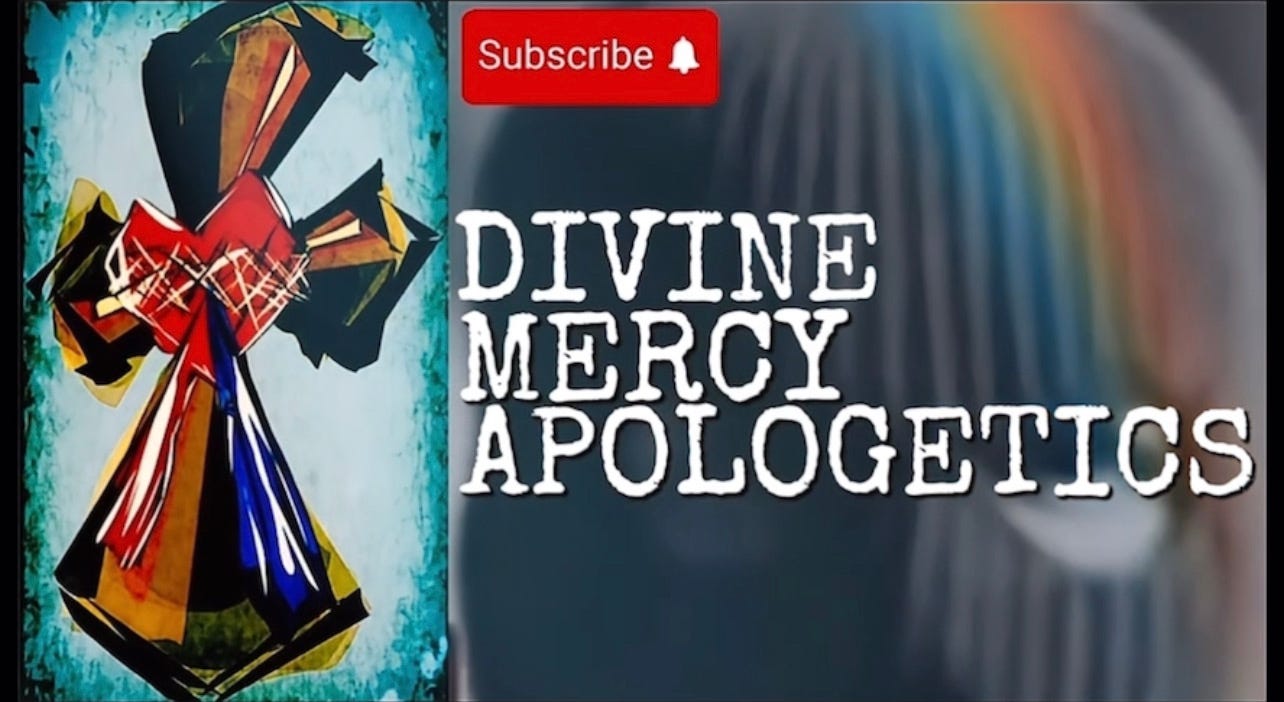
IF YOU WOULD LIKE TO SUPPORT OR INTERACT WITH ME:
YOUTUBE: DIVINE MERCY APOLOGETICS
DISCORD: DIVINE MERCY APOLOGETICS
INSTAGRAM: DIVINE MERCY APOLOGETICS
For a YouTube presentation about the examination of the Chieti Document:
PART 1: DIVINE MERCY APOLOGETICS
PART 2: DIVINE MERCY APOLOGETICS
PART 3: DIVINE MERCY APOLOGETICS
PART 4: DIVINE MERCY APOLOGETICS
References and BIBLIOGRAPHY:
(1) SAINT JOHN CHRYSOSTOM, Explicatio in Ps. 149: PG 55, 493.
(2) A Response to the Joint International Commission for Theological Dialogue between the Roman Catholic Church and the Orthodox Church Document “Synodality and Primacy during the First Millennium: Towards a Common Understanding in Service to the Unity of the Church” (2016), document published: October 28th, 2017. Weblink
(3) SAINT PETER CHRYSOLOGUS, Letter XXV: PL 54, 743. (trans: E. Giles).
(4) SAINT GREGORY NAZIANZEN, Carmen de Vita Sua I, PG 37, 1068. (trans: E. Giles).
(5) SAINT MAXIMUS the CONFESSOR, Opscula Theologica et Polemica XII PG 91, 141-146.
(6) SAINT CYPRIAN of CARTHAGE, Epistle XXXIV, PL 4, 336.
(7) SAINT JOHN CHRYSOSTOM, Homily for John I, PG 59, 480.
(8) SAINT. JOHN CHRYSOSTOM, Homily LIV for Matthew XVI, PG 58 ,534.
(9) SAINT. JOHN CHRYSOSTOM, Homily XXXII for Romans XVI. 17, 18, Trans. by J. Walker, et al. From Nicene and Post-Nicene Fathers, First Series, Vol. XI. Edited by Philip Schaff – PG 60, 670-678.
(10) SAINT CYRIL of JERUSALEM, Catechetical Letter VI, XV – On Heresies, trans. R. W. Church, in A Library of Fathers of the Holy Catholic Church (Oxford; London: J. H. Parker; J. G. and F. Rivington, 1838), 68 – PG 33, 562.
(11) Catholic Answers. Weblink
(12) Catholic Answers; Dr. James Likoudis. Weblink
(13) Doctor James Likoudis, The Divine Primacy of the Bishop of Rome and Modern Eastern Orthodoxy, page 77.
(14) SAINT IGNATIUS of ANTIOCH, Epistolae ad Romanos I, PG 5, 16-23.
(15) ibid.
(16) SAINT IGNATIUS of ANTIOCH, Epistolae ad Romanos I:i, The Apostolic Fathers, EARLY CHRISTIAN WRITINGS, trans. MAXWELL STANIFORTH Revised translation, Introductions and Notes by ANDREW LOUTH. Weblink.
(17) SAINT IGNATIUS of ANTIOCH, Epistolae ad Romanos III, trans. Alexander Roberts and James Donaldson. From Ante-Nicene Fathers, Vol. 1. Edited by Alexander Roberts, James Donaldson, and A. Cleveland Coxe. NY: Christian Literature Publishing Co., 1885.)
(18) SAINT CYPRIAN of CARTHAGE, Epistolae XXXIX, v, trans. Robert Ernest Wallis. From Ante-Nicene Fathers, Vol. 5. Edited by Alexander Roberts, James Donaldson, and A. Cleveland Coxe.(Buffalo, NY: Christian Literature Publishing Co.,1886.) Revised and edited for New Advent by Kevin Knight. PL 4, 336.
(19) SAINT ATHANASIUS of ALEXANDRIA, De Sententia Dionysii, Section XIIII, trans. Archibald Robertson. From Nicene and Post-Nicene Fathers, Second Series, Vol. IV. Edited by Philip Schaff and Henry Wace. (Buffalo, NY: Christian Literature Publishing Co., 1892.)
(20) Doctor Luke Rivington (M.A), The Primitive Church and the See of Peter, Magdalen College, Oxford. London, Longmans, Greens and co and New York: 15 east 16th street, 1894 chapter xi, s I – part I, page 161-162.
(21) Council of Chalcedon, Session I, trans. Henry Percival. From Nicene and Post-Nicene Fathers, Second Series, Vol. 14.Edited by Philip Schaff and Henry Wace. (Buffalo, NY: Christian Literature Publishing Co., 1900.) Revised and edited for New Advent by Kevin Knight.
(22) EMPEROR MARCIAN (Eastern Orthodox saint) to POPE ST. LEO THE GREAT; Mansi 6: 93.
(23) EMPRESS PULCHERIA (Eastern Orthodox saint) to POPE ST. LEO THE GREAT; Mansi 6: 101.
(24) EMPEROR CONSTANTINE VI and EMPRESS IRENE OF ATHENS to POPE HADRIAN; Labbe and Cossart, Concilia, Tom. VII., col. 32.
(25) MOECHIAN CONTROVERSY, H. G. Beck, Kirche und theologische Literatur im byzantinisch en Reich 491–494, 515. P. J. Alexander, The Patriarch Nicephorus of Constantinople(Oxford 1958). Encyclopaedia Weblink
(26) SAINT THEODORE the STUDITE of CONSTANTINOPLE to POPE SAINT LEO III; Epistle XXXIII. PG 99, 1017.
(27) New Advent; Jovinianus and St. Jerome. Weblink
(28) SAINT JEROME, Adv. Jovianum I, xxvi; PL 23, 258.
(29) POPE SAINT SIRICIUS to BISHOP HIMERIUS of TARRAGONA, Directa Ad Decessorem, Epistolae I, P. Coustant, Epistolae Romanorum pontificum, Paris, 1721. 623-638; PL 13, 1132.
(30) Encyclopaedia Britannica; Iconoclasm. Weblink
(31) SAINT THEODORE the STUDITE, Epistola ad Paschalem I Papam; PG 99, 1281.
(32) ST. JOHN of DAMASCUS, Homilia in Transfiguratione II; PG 96, 548.
(33) ST. JOHN of DAMASCUS, Homilia in Transfiguratione IX; PG 96, 560.
(34) Encyclopaedia Britannica; Charlemagne. Weblink
(35) POPE HADRIAN to CHARLEMAGNE, Epistola Hadriani Papae ad Carolum Magnum; MANSI 13, 808.
(36) Canons of SYNOD or SARDICA/ PHILIPPOPOLIS,
Hfl-Lec 1, 737-823;
Or
DTC 14, 1009-1014;
Or
M. Simonetti, 161-187;
Or
L.W. Barnard, The Council of Serdica: Some Problems Re-assessed: Annuarium Hist. Conc. 12 (1980) 1-25;
Or
The Site of the Council of Serdica: SP 17, Oxford 1982, 9-13;
Or
The Council of Serdica 343 A.D, Sofia 1983;
Or
I. Opelt, Die westliche Partei auf dem Konzil von Serdica, in Spätantike und frühbyzantinische Kultur Bulgariens zwischen Orient und Okzident, ed. von R.Pillinger, Vienna 1986 85-92; R. P.C. Hanson, The Search for the Christian Doctrine of God: The Arian Controversy, 318-381, Edinburgh 1988;
Or
B. H. Stolte, La chiesa orientale e i canoni “occi-dentali,” in Il tardoantico alle soglie del duemila: diritto, reli-gione, società, ed. G. Lanata, Pisa 2000, 165-175; H. Hess, The Early Development of Canon Law and the Council of Serdica, New York 2002.
(37) ibid.
(38) ibid.
(39) ibid.
(40) Encyclopedia.com; C. J. Von Hefele, Histoire des conciles d’après les documents originaux, tr. and continued by h. leclercq, 10 v. in 19 (Paris 1907–38) 1.2:737–823.
Or
C. J. Von Hefele, Histoire de l’église depuis les origines jusqu’à nos jours, eds., a. fliche and v. martin (Paris 1935–) 3:123–130. h. hess, The Canons of the Council of Sardica, A.D. 343(Oxford 1958).
Or
P. Joannou, Discipline générale antique (II e–IXes. ) (Sacra Congregazione Orientale, Codificazione orientale, Fonti, 1962–) 1.2:156–189.
Or
S. G. Hall, “The Creed of Sardica,” Studia Patristica, 19 (1989): 173–184. l. w. barnard, The Council of Sardica, 343 AD (Sophia 1983).
(For all sources above [in 40], consult Weblink)
(41) Canons of TRULLO,
CPG 9443-9444;
Or
Hfl-Lecl 3, 560-578;
Or
Mansi 11, 921-1006;
Or
Joan-nou, I, 1, 101-111; DTC 13, 1581-1597 (see Tables 1, 732f.);
Or
I canoni dei concili della Chiesa antica, I, I concili greci, ed. A. Di Be-rardino, Rome 2006, 91-182 (Greek text and Ital. trans.), R.M.T.
Or
Cholij, Married Clergy and Ecclesiastical Continence in Light of the Council of Trullo (691): AHC 19 (1987) 71-230; 241-299;
Or
H. Ohme, Das Concilium Quinisextum und seine Bischofsliste. Studien zum Konstantinopoler Konzil von 692, Berlin-New York 1990;
Or
Holy Cross Conference: The Council “in Trullo’; Basis for Ecclesiastical Reform?, A Conference Commemorating the 1300th Anniversary of the Penthekte Ecumenical Council “in Trullo,”‘ Brookline, MA 1995;
Or
H. Ohme, Das concilium Quinisex-tum. Neue Einsichten zu einem umstrittenen Konzil: OCP 58 (1992) 367-400; G. Nedungatt – M. Featherstone, The Council in Trullo Revisited, Rome 1995;
Or
A.C. Calivas, The Penthekte Synod and Liturgical Reform: The Greek Orthodox Theological Review 40 (1995) 125-147;
Or
M. van Esbroeck, Armenien und die Penthekte: AHC 24 (1992) 78-94;
Or
H. Ohme, The Causes of the Conflict about the Quinisext Council: New Perspectives on a Dis-puted Council: The Greek Orthodox Theological Review 40 (1995) 17-43;
Or
EPapi 1, 633-637.
Or ENGLISh:
Trans. Henry Percival. From Nicene and Post-Nicene Fathers, Second Series, Vol. 14. Edited by Philip Schaff and Henry Wace. (Buffalo, NY: Christian Literature Publishing Co., 1900)
(42) Council of CHALCEDON,
DTC 2, 2190-2208;
Or
Hfl-Lecl 2, 649-888;
Or
CGG 1, 243-418; R.V. Sellers, The Council of Chalcedon, London 1953;
Or
P.Th. Camelot, Ephèse et Chalcédoine, Paris 1962; L.R. Wickham, Chalkedon: TRE 7 (1981) 668-675;
Or
A.J. Festugière, Actes du con-cile de Chalcédoine. Sessions III- VI, intr. by H. Chadwick, Ge-neva 1983;
Or
A. Grillmeier, Jesus der Christus im Glauben der Kirche. 2/1. Das Konzil von Chalkedon (451). Rezeption und Widerspruch (451-518), Freiburg – Basel – Vienna 1986;
Or
J. Vogt, Ephesus. Konzil u. Synoden: LTK3 3, 706 f.; E. Reichert, Nesto-rius: BBKL 6 (1993) 629-633;
Or
Heresy and Orthodoxy in the Early Church, London 1991, nr. 18; R. Kirchschläger – A. Stirne-mann (eds.), Chalkedon und die Folgen. Festschr. Z. 6o. Geburtstag v. Bisch. Mesrob K. Krikorian, Innsbruck- Vienna 1992;
Or
A. de Halleux, Nestorius. Histoire et doctrine: Irénikon 66 (1993) 163-177;
Or
L. Perrone, L’impatto del dogma di Calcedonia sulla rif-lessione teologica tra IV e V Concilio Ecumenico, in A. Di Berardino – B. Studer (eds.), Storia della teologia, I, Casale Monf. 1993, 568ff.;
Or
W. Breuning, Chalkedon 2. Das Konzil von Chalkedon: LTK32, 999-1002;
Or
J.W Need, Human Language and Knowledge in the Light of Chalcedon, New York 1996;
Or
P.Th. Camelot, Storia dei concili II: Efeso e Calcedonia, It. tr., Vatican City 1997; J. van Oort – J. Roldanus (eds.), Chalkedon: Geschichte und Aktualität, Louvain 1997;
Or
M. Fedou, Chalcédoine (Concile), 451, in J.-Y. Lacoste (ed.), Dictionnaire critique de théologie, Paris 1998, 266ff.;
Or
A.M. Ritter, s.v. Chalkedon, Konzil von 451: RGG+ 2, 92ff.; A.M. Ritter, s.v. Chalcedonense, christol-ogische Definition, ibid., 93ff.;
Or
A.M. Ritter, Das Konzil von Chalkedon, in C. Andresen – A.M. Ritter (eds.), Handbuch der Dogmen und Theologiegeschichte, I, Göttingen 31999, 261-270;
Or
K.-H. Uthemann, Zur Rezeption des Tomus Leonis in und nach Chalkedon. Wider den dogmenhistorischen Begriff “strenger Chalkedonismus,” SP 34, Louvain 2001, 572-604.
(43) Session 1, CHALCEDON [see reference 42].
(44) POPE SAINT LEO I the GREAT, Sermo V; PL 54, 153.
(45) EMPEROR SAINT MARCIAN to POPE SAINT LEO I the GREAT, Epistolae X; Mansi VI, 226.
(46) BISHOP ANATOLIUS of CONSTANTINOPLE to POPE SAINT LEO I the GREAT, Epistolae CXXXII; PL 54, 1094.
(47) Session 2, CHALCEDON [see reference 42].
(48) Session 3, CHALCEDON [see reference 42].
(49) Session 4, CHALCEDON [see reference 42].
Answering Islam – Sam Shamoun Theology Newsletter
Join the newsletter to receive the latest updates in your inbox.

